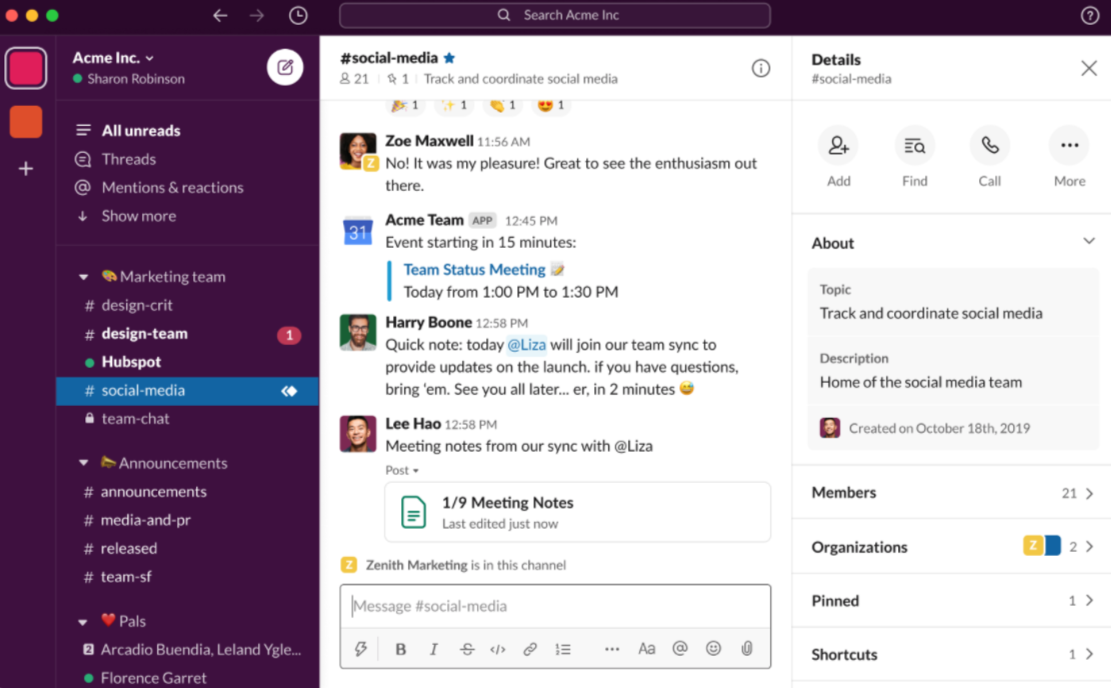Trying to figure out how to use Slack?
Good. It’s totally worth it.
Boasting 10+ million daily active users, the popularity of Slack speaks for itself. In fact, the platform is now a staple of remote work as more and more teams rely on Slack as their all-in-one communications hub.
And while Slack might seem like just a chat app on the surface, the platform boasts a whole slew of time-saving features to keep teams productive and engaged.
In this guide, we’ll break down how to use Slack for business.
What is Slack, anyway?
Let’s start with the basics.
Slack is a team collaboration and project management tool. The platform can be used in-browser or as its own native app on desktop and mobile.
Users communicate in channels denoted by specific hashtags. For example, a marketing team might have separate channels for #content-writers, #SEO and #design.

Within each channel, users can tag each other based on their @handles. Then the fun begins.
In terms of how to use Slack to communicate, your options are pretty much limitless. For example, Slack is a great alternative to emails or project tickets. Having such messages forward-facing creates a sense of accountability and transparency as teams can track their communication from Point A to Point B until an issue is resolved.

Slack can also be used for informal communication. Celebrating a new contract or birthday? Want to drop some memes or .GIFs? Go for it.

Users can change their availability status throughout the day to signal to colleagues when they’re down to talk versus when they’re doing deep work.
In short, Slack serves as a place for coworkers to always be “on.” This provides a more timely alternative to communicating exclusively via email, while also recreating the old-school office watercooler.
Why is Slack so popular with remote teams, though?
Slack might not seem so special at a glance.
After all, there are plenty of chat apps out there (think: Teams, Google Meet) that serve a similar purpose.
Slack’s popularity can be boiled down to its widespread use among startups and an influx of millions of new users during COVID-19. Early in the pandemic, businesses defaulted to a handful of apps to adapt to the newfound “normal” of remote work.
And for team chat, Slack was the winner. The app experienced a surge in new users in the midst of COVID-19 and many have since decided to stick with the platform for the long-term.
Perhaps the biggest selling point of Slack is its third-party integrations. If there’s a business app or tool you rely on, there’s a high chance it has a Slack integration.
Trello. Google Drive. Outlook. You name it, Slack integrates with it.
Another key distinction of Slack versus other chat apps is the platform’s variety of bots, many of which are focused on productivity and improving company culture. For example, the popular Donut bot is designed to optimize new employee onboarding and help employees build relationships in a remote setting.

A big-picture goal of using a platform like Slack is to replace email outright (or at least reduce teams’ reliance on email).
Why use Slack instead of email, though? Time.
It’s well-documented that many workers waste hours per day in their inboxes. The platform cuts down on needless back-and-forth, consolidating email notifications into a real-time inbox alongside your team chat. For example, you can schedule and share a Zoom meeting ID directly within Slack without bouncing between inbox links and invites.

How do most remote companies use Slack?
No two teams use Slack the same, but the end-goal is the same: give teams a place to stay connected without wasting time in their inboxes or juggle a bunch of apps.
Below are three specific goals for remote companies trying to figure out how to use Slack:
- Streamline tasks and document internal communication among workers
- Encourage timely, open communication and a collaborative company culture
- Keep employees productive through apps and integrations
The platform is a prime place for teams to brainstorm ideas and keep a pulse on the status of any given project. For example, creative remote teams might ask for feedback or finalize a piece of content. Here’s an example of how to use Slack for project management (with Trello) to do exactly that:

Meanwhile, boosting employee engagement is one of the biggest challenges of managing a remote team. Slack can help in that department thanks to its variety of engagement bots and survey tools to pick workers’ brains.
Here’s an example using Polly, which provides workers an anonymous place to give feedback and answer questions from managers.

And again, Slack’s goal is to make sure that employees stay productive. This is yet another challenge of remote teams where workers are independent and keeping track of individual tasks can be a hassle.
Here’s an example of how a time-tracking tool like Timebot.chat, which gives workers somewhere to track their day-to-day tasks, blocks out time and highlights what they’ve been working on.

This is just a snapshot of how to use Slack as a remote team. Your preferred apps and workflows might be different, but you can use the platform all the same.
How to use Slack: tips and best practices
Although Slack itself is pretty intuitive, using the platform to its fullest potential means understanding its best practices. Here are some quick tips for making sure that your team uses Slack in a meaningful way.
Pick out your channels
Your company’s Slack shouldn’t be a free-for-all of random channels. Instead, discussions should be confined to channels based on your company’s goals for the platform.
For example, does each team have a place to go back-and-forth? Is there somewhere to express company-wide concerns? Do you want to confine memes and funny business to a single channel?
There is no “right” way to set up your Slack channels. Of course, this freedom can be a bit daunting. To get started, here are some examples of recommended channels highlighted by Slack itself.
- #Announcements
- #Random
- #AMA (ask me anything)
- #Company-culture
- #Suggestion-box
Outline expectations
Not unlike social media, some critics regard Slack as a potential time-sink for employees that can actually result in less productivity.
Additionally, the phenomenon of “Slack fatigue” and stress from pushy users on the platform can contribute to workplace burnout.
It’s important to highlight expectations for how to use Slack among your team. This can avoid time-wasting and likewise ensure that discussions are meaningful and productive.
In short, teams shouldn’t just see it as a place to chat. We recommend Slack’s own guide to onboarding your company to make sure that your team is on the right track from the word “go.”
Take full advantage of integrations
If you’re using Slack for business, you’re spoiled for choice in terms of the integrations you can use. This includes:
- Project management tools (Trello, Asana, Jira)
- Video meeting tools (Zoom, RingCentral)
- Calendar apps (Google Calendar, Outlook)
- Collaboration software (Google Drive, Box)
- Employee engagement tools (OfficeVibe, TINYpulse)
For example, look at Slack G-Suite for Slack. With a single integration, you can manage your meetings…

…and upload files to share with the rest of your team.

But again: the goal of Slack is to save time. It might be tempting to cram as many apps and integrations into the platform as possible, but try to stick to the most-used ones first.
Promote positivity
This might sound corny, but it’s definitely worth mentioning.
Your colleagues shouldn’t dread opening any given Slack channel. Whether it’s feedback or requests, stress the importance of keeping communication positive and constructive.
There’s no doubt that being connected around-the-clock to your team can be potentially stressful. To combat this, encourage your team members to mind their tone and likewise not be afraid of letting their personalities shine. Slack is a brilliant team-building and collaboration tool, granted teams understand how to approach it.
And with that, we wrap up our guide on how to use Slack!
Ready to get started with Slack?
While the concept of learning any new platform might be a headache, getting started with Slack is easier than you might think.
No matter what sort of business you’re running, Slack can bring your team closer together while also supporting your bigger business goals. We recommend it to just about anyone looking to get more work done, especially social marketers.
And just like figuring out how to use Slack effectively empowers your team to be productive, keep in mind that Sprout Social can help you do the same.
This post How to use Slack to keep your remote team productive and engaged originally appeared on Sprout Social.